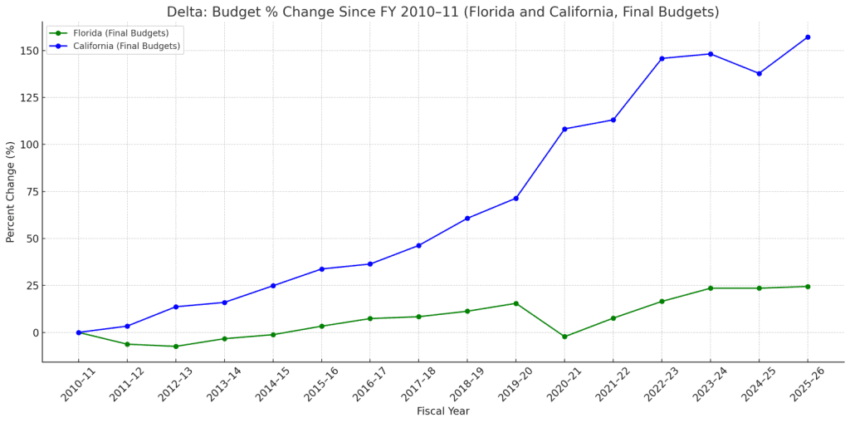Two of the nation’s biggest states—California and Florida—recently passed state budgets that are vastly different in size and scope, reflecting a fundamental dichotomy in governance style between the two states, both of which have partisan supermajorities and trifectas. The vastly different outcomes between these two states should give pause to any legislators that wish to spend their state’s future away.
Having evolved from razor-thin swing state margins in 2018 to GOP dominance in 2024, the zero-income-tax state of Florida has become a case study in how conservative governance helps a state grow. Florida’s $115 billion 2025-26 budget included a $1.3 billion tax cut, including reducing sales tax on commercial leases—a tax cut for most businesses in the state—and tax cuts for school supplies and disaster preparedness.
The Florida budget bill also gives the state oversight over runaway local spending. Florida’s 2025-26 budget decreases spending by $3.5 billion, whilst also allowing for the state to save money in its budget stabilization fund rather than waste those funds on government programs. Having posted surpluses in recent years, even while slashing taxes, Florida is on track to thrive in the years to come.
California, however, has yet to take the first step towards recovery: acknowledging that they have a spending problem. As the state contends with a $12 billion deficit, lawmakers may recall an even more alarming $100 billion deficit from a couple years ago. Yet they still seem reluctant to make the necessary spending cuts.
Above is a chart that that shows the percentage change in the annual budget in Florida (green) and California (blue).
Now that the California Assembly passed a $325 billion budget, which increases from $288 billion in the previous year, questions have risen over whether the Golden State will ever have the courage to rein in spending. Senate Budget Chair Scott Wiener (D-San Francisco) declined the possibility of any cuts, even on unpopular programs like the expansion of MediCal to illegal immigrants or continued spending on failed public transportation projects like the “Train to Nowhere”. Some lawmakers are simply hoping for a “miracle” turnaround in the state economy, even as they actively double down on anti-growth, big-government policies that are sinking their economy. Fiscal responsibility is not likely to be a priority of the state anytime soon.
It should be noted that Florida does not need a miracle in order to spend significantly less per resident to achieve better outcomes. Florida spends about $4,920 per resident, whereas California spends $8,220 per resident. That’s 67% more government than Florida. With Florida reporting GDP growth of 5% in 2023, having outperformed California’s 2.1%, there is mounting evidence that the Sunshine State’s way is winning.
With no income tax, a bustling economy and a government that leaves its residents alone, Florida leads the nation for positive internal migration, whereas California is losing residents to Arizona and Texas. It’s clear that residents prefer low- and zero income taxes to California’s 14.4% top marginal rate, plus a 7.25% state sales tax that heads well into double digits in many localities like Los Angeles County, which can levy their own sales taxes too.
Governor Gavin Newsom, who is currently auditioning for the Democratic nomination in 2028, has long forwarded false claims about Florida’s tax burden on families, hiding the real truth on California’s tax burden for workers of all incomes. Newsom’s claim comes from an analysis formulated by a progressive think-tank, which stated that poorer Florida residents spend more of their income on sales and property taxes than California’s richest residents.
However, analysis from the Tax Foundation finds that the aggregate tax burden for Florida income-earners is 9.1%, whereas it is 13.5% for California. Furthermore, the organization ranks Florida #4 for tax burden, whereas it ranks California #48 on the same metrics. Even when Gov. Newsom is desperate to claim a win, the facts prove him wrong again and again.
As California’s bloated budget drives the state’s economy, cost of living, and education outcomes into the ground, it is only a matter of time before the Golden State goes bust – unless, of course, they take a page out of Florida’s book at last.
Click this link for the original source of this article.
Author: Rohan Naval
This content is courtesy of, and owned and copyrighted by, https://www.atr.org and its author. This content is made available by use of the public RSS feed offered by the host site and is used for educational purposes only. If you are the author or represent the host site and would like this content removed now and in the future, please contact USSANews.com using the email address in the Contact page found in the website menu.








